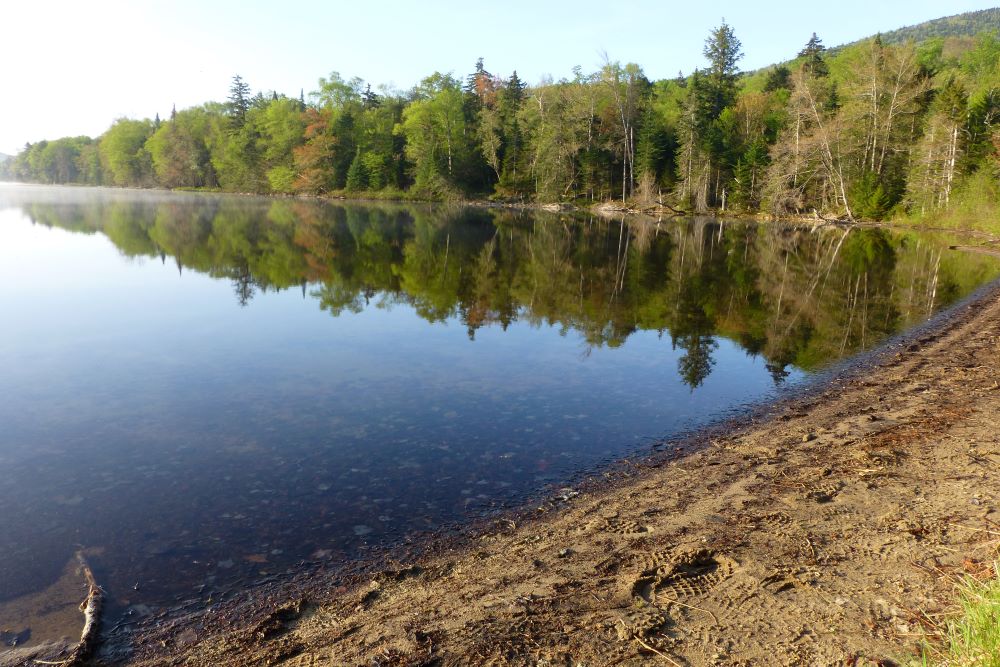Spring on the NPT
Spring on the NPT
by Jeffrey Case
In the Spring a fuller crimson comes upon the robin’s breast;
In the Spring the wanton lapwing gets himself another crest;
In the Spring a livelier iris changes on the burnish’d dove;
In the Spring a young man’s fancy lightly turns to thoughts of love.
So said Alfred, Lord Tennyson, in “Locksley Hall.” And, while all of that may be true, particularly during spring in Victorian London, my thoughts in spring turn to hiking the Northville-Placid Trail (NPT). Twenty-nine of the thirty times I’ve done end-to-end trips on the NPT, it has been in the spring.
So when I see the robin’s breast, the pileated woodpecker’s crest, or the iris’s bloom, I know it’s time to make beef jerky, drag the stuff out of my pack, and start buttering up my friends so they won’t mind jockeying my car from Northville to Lake Placid.
Even before I began hiking it, I fell in love with the NPT.
A wilderness trail
My first wife and I were novice backpackers perusing gear and equipment at the local outdoor store when I first heard about the NPT. The store had a small selection of publications, including ADK’s guide to High Peaks trails. But then I came across a modest-sized, white-and-blue trail guide. The funny thing was that it wasn’t about a region in the Adirondacks, but rather about a single trail. Right away that concept caught my attention.
“What is there about this trail,” I asked the store owner, “that makes it so special?”
“It’s 133 miles long. It goes across the whole Adirondack wilderness,” he said. Interesting.
Another customer happened to be standing nearby and he chimed in, “That is one tough trail. My wife and I tried to do it twice, and twice she slid off logs and broke her wrist. We’re never going back there.” Unfortunate, yes, but accidents can and do happen on any trail, not just this one.
Maybe we could do it, I thought. The distance seemed reasonable enough. I wouldn’t have to quit my job or sell my house to hike it, as would be the case with the Appalachian Trail. We were used to doing weekend trips of maybe eight to ten miles per day. What if we could just string a half dozen weekend trips together? Would that be doable? We began to toss the idea around.
Pretty soon I went back and bought the book. Reading it, I learned the trail crosses the road in Piseco, Blue Mountain Lake, and Long Lake. Further, each of these towns has a post office that can be used for resupply, as well as sending things home. The thought of mailing myself a package of food to each town was way too cool. Well, that upped the accessibility factor for sure.

What really appealed to me was the “wilderness” moniker. I guess all I knew about the Adirondacks at the time was the Olympics and the road up Whiteface Mountain. But would we actually be able to survive in the wilderness? I mean, wasn’t that dangerous? After all, once you leave your car behind, you’re on foot for two weeks. What if something happens or goes wrong? Then what are we going to do?
What ifs
It seems the wilderness brought a whole basket of worries with it. Fortunately, thoughtful conversation, questioning experienced hikers, and quite a bit of determination got us through and allowed us to succeed in completing our first end-to-end trip on the NPT.
However, our accomplishments were not without obstacles. For example, several days into our very first trip, our dog developed a urinary tract infection. How on earth could we get her to a veterinarian for treatment?
The midway point of the trip is Blue Mountain Lake. While we were picking up our food drop from the post office there, the postmaster asked how our trip was going. Fine, I replied, except for the plight of our dog. She had heard there was going to be a veterinary clinic in Long Lake and volunteered to make a phone call to find out when. Wouldn’t you know, it was the next day. But the question was, how would we get there with no car?
Later, after the return hike to our campsite, we struck up a friendly conversation with a father and son who were fishing. We explained our situation and, without hesitation, the father offered to drive me and our dog to the clinic the next day.
Another obstacle presented itself the following year. I severely sprained my ankle when reentering the woods after Piseco, and I could barely walk on it, as it swelled to the size of a grapefruit. We had no choice but to wait at Fall Stream, soaking my foot in the very cold water and hoping the swelling would soon subside so we could hike out. But then, how would we get to our car that had been relocated to Lake Placid by friends?
The next morning, while we were lounging by the stream where I had my foot in the freezing water, a thru-hiker came passing by. We asked if he had enough provisions, since we would no longer be needing ours. He replied that, as a matter of fact, he felt he did not have enough. He welcomed our offer to share with him and we gladly gave him all of our Snickers candy bars and freeze-dried entrées. He happily departed and we went back to our books. A short time later, he came down the trail and stopped. He had been thinking about our situation and felt he may have a solution.
He said he had begun his hike in Piseco and his car was back at the last trailhead. However, he was hiking to Long Lake and had no idea how he would get back to his car when he was through. “So,” he said, “you seem like nice people. If I give you the keys to my car, you can hike out to the trailhead and drive to Lake Placid to get your car. Then, if you would please drive my car back to Long Lake and leave it there for me, we would both be happy. You’d have your car and I’d have mine.” Well, that was certainly the answer to a prayer. Needless to say, we took him up on his offer.
Over the years, we have had occasion to use floatplanes. In 1991 we were carrying a rather high-tech tent; it was the preproduction prototype that was actually photographed for the company’s catalog. We had pitched it at the north end of Tirrel Pond and enjoyed a nice night’s rest.

The next morning, we awoke to a glorious sun-filled, blue-sky day. After breakfast, as we were dropping the tent to pack up, we received a couple of visitors. We enjoyed some pleasant conversation. After they left, we finished up and headed down the trail. We went up and over the ridge on the side of Blue Mountain, worked our way down along Sandy Creek, crossed the spruce swamp, climbed up Tarbell Hill Road, and continued on to Catlin Bay to make camp.
Once there, we decided to use the lean-to rather than pitch the tent, which we did. That was, until the blackflies discovered the new food source in the area. We decided to gain some relief by pitching the tent and staying there until the little buggers went to bed at sundown. However, we soon realized we had inadvertently left one small, golden-colored, preformed, lightweight aluminum, very expensive tent pole all the way back at Tirrel Pond.
Without this pole, the tent could not be pitched. Not tonight, or for the rest of the trip. To make matters worse, we had been awakened the previous night by a large porcupine who thoroughly enjoyed gnawing on the aluminum external frame of my pack, which meant I had to get that pole before he came back for dessert! Hmmm.
It would take one full day to hike back to get the pole, and another to return. We didn’t have two days to spare. Additionally, the tent, as nice as it was, was no longer in production, so getting a replacement pole was doubtful. The next morning, we went into Long Lake to get the supplies we had mailed for the rest of the trip. I spotted a seaplane ride sign and moseyed on over.
“How much would you charge to fly into Tirrel Pond?” I asked.
“That depends. How many people and how much gear?”
“Just me and my camera,” I replied. “I left a tent pole there. I think I know right where it is. I can get it in two minutes after we land.”
“Twenty-five bucks,” he replied.
Before I knew it, I was sitting directly behind pilot Tom Helms in the cockpit of a two-seat, canvas-covered floatplane. I snapped a picture of Donna and Brit as they waited on Long Lake’s beach as I flew overhead. In just a few minutes, I was running up the trail to where we had stayed. There, on the yellow and gold leaves on the forest floor, was our tent pole. I grabbed it and ran back to the plane before Tom had even finished turning it around to point it the other way for take-off. The view from the air was awesome. And most importantly, I had the pole.
Of course, there have been many other challenges, like the year the bridge over West Canada Creek was out and the creek, at flood stage, was uncrossable. So, we turned around and hiked all the way back to the start.
Or the time we unexpectedly encountered waist-deep snow—snow that was not going to melt anytime soon. We retreated and restarted some time later. Then there was the case of the curious food thief at Duck Hole one year. We, along with a pair of college-aged hikers, had hung our bear bags properly near each other before retiring for the night. We woke up early the next morning to lines that had been cut.
I guess, in the end, one of the most valuable things I look forward to in the spring on the NPT is the opportunity to tune out the busy, electronically intrusive world we live in. When you get out in the woods and hit the trail, all that world becomes lost in your mind as you assume the gentle cadence of putting one booted foot in front of the other, step after step. Time isn’t critical anymore. Technology is left behind. The pace slows.
Funny how the only things that matter out there are walking, eating, and sleeping. Staying warm. Staying dry. Walking, eating, sleeping. To be hiking the Northville-Placid Trail in the spring is a beautiful thing.
Jeffrey Case has been editing the Adirondack Mountain Club Northville-Placid Trail guidebook for over twenty years.
To celebrate 100 years of adventure on the NPT, ADK is sharing your stories online and in print. Visit bit.ly/npt-story to submit your NPT story, or head to NPT100.com to blaze a new trail.
Related
Mud Season: Quick Facts
Just what is mud season? Running anytime from late March into mid-June—it varies each year […]
Impromptu Honeymoon on the NPT
by Addison Wolanin My wife, Shannon, and I got married in July 2020—and we all […]
ADK’s Visitor Centers Provide Critical Services
February 7, 2024 — Lake Placid, NY — Data from two Adirondack Park visitor centers […]
ADK Announces 42nd Annual Paddle Outing
January 18, 2024 Paddle in, and adjacent to the St. Regis Canoe Area – the […]

